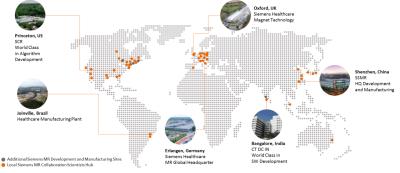Adoption & Commercialization of the Novel Techniques: Vendors' Perspective
1Siemens Healthineers, Erlangen, Germany
Synopsis
Siemens Healthineers is the MRI vendor with the largest market share in MR. Our main goal is to facilitate advances by providing a reliable platform for MR applications and research to generate added value to users and patients. Here we want to outline important criteria to leverage product integration of new methods and trends. Using prototypes, multi-center testing can be employed to validate new methods. Based on collaboration, a Works-in-Progress can be developed for wider validation and as input for productization. Siemens Healthineers just recently reemphasized its commitment to actively support 3rd-party integration as integral part of clinical solutions.
Outline
Siemens Healthineers is the MRI vendor with the largest market share in MR (~40%, installed base >17,000 systems) investing > $1.1 billion per year in R&D. One major contributor to our success are the collaborations with leading institutes around the world. Despite its long history of developments, MRI today is still a field with most significant innovations. These are often driven by ideas from our partners. One main goal of Siemens Healthineers MR (SHMR) is to provide and sustain an environment within active collaborations that facilitates advances by providing a reliable platform for leading MR applications and research worldwide (open innovation = “inviting others to play”). The ultimate goal is to generate significant added value to the users of SHMR solutions and finally patient outcomes, in a timeframe as short as possible from idea to product (shortening time to market by efficient processes). However, not every idea can be turned into a product in short time due to limited resources on the one hand with the need to prioritize requirements, and a large range and multitude of new applications emerging from a strong research community and driven by the great versatility of MR. Therefore, it is important to check the criteria which are important to leverage product integration of new methods:
• Provision of clinical validation for new methods against gold standard
• Sufficiently high technical maturity level (“technology readiness”)
• Generic implementation for wide applicability
• High level of system/software integration (e.g. based on product code)
• Low remaining efforts for product integration (including testing, regulatory approval)
• IP situation clarified à freedom to operate
• Substantial user- and business-impact (“roadmap match”).
To address the needs for turning an idea into a product, it may help to look at the typical development steps:
1. Observe and support prototyping activities at research sites
2. Ask experts/users: Which new methods will make it to the clinical MR scanners?
3. Answer from Experts (many different topics, “productization funnel”)
4. Complex but well-defined process - how to achieve proper prioritization?
5. WIP implementation and clinical evaluation together with customer
6. Product implementation
7. Product release and marketing.
Directions for innovation
“Innovation can be defined simply as a ’new idea, device, or method’. However, innovation is often also viewed as the application of better solutions that meet new requirements … or existing market needs” (source: Wikipedia). Of course, innovations around the “core” of an MRI experiment (MR hardware design, scanning sequences, reconstruction and processing) are of high importance. But also anything around and beyond this core can make MR exams more efficient (e.g. workflow, planning, scan adjustments à table time vs. scan time) and innovation in those areas have constantly gained importance over the past years. SHMR is eager to leverage and shape emerging trends in healthcare and in relevant technology fields (e.g. aging population; patient focused, personalized MR; cost pressure, industrialization, consolidation; artificial intelligence, big data; green technology). The BioMatrix technology embedded in our new MAGNETOM Vida [1] is a good example for how we embrace emerging technologies to advance patient care and address emerging needs in a changing healthcare market. To develop our business further, we aim at growing MRI usage towards new emerging fields , e.g. by expanding procedures to new patient groups / referrals, into the therapy business, to centers with less expertise, into application areas that are at present dominated by other modalities, by expanding our portfolio to advancing field strengths and hybrid systems, etc. More specifically, innovations in SHMR are actively pursued in the areas of acquisition speed, to address motion, and towards quantification. Any idea or method that can help to cover these aspects is potentially a starting point for MR innovation, and SHMR is open for starting or expanding collaborations along these directions. By providing an open innovation platform for developing MR applications on all levels (“IDEA” for sequence and ICE/reconstruction, “Dot” framework for workflow, “Frontier” for post-processing), SHMR seeks to be the enabler for successful development at individual or at multiple collaborating academic research sites. Starting with a prototype for local testing, processes for multi-center testing (“Core Competence Partnership”, “C2P”) can be employed to generate clinical evidence for the validity and robustness of a new method. As a result of close collaboration, a Works-in-Progress (“WIP”) / “Application Support Package” (ASP) can be developed for wider testing and clinical validation and finally serve as input for product integration. SHMR just recently has reemphasized its commitment to also actively support 3rd-party integration (devices, 3rd party processing like “Arterys”, open source prototyping platfoms like “Gadgetron”). By introducing new environments (“teamplay”, “Next Generation Frontier”) SHMR continuously expands its interfaces for external partners to hook up into the data flow (“Digital Ecosystem”) and establish 3rd-party applications as integral part of clinical solutions.
[1] 510(k) pending. The product is still under development and not commercially available yet. Its future availability cannot be ensured.
